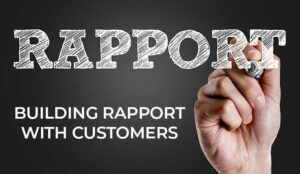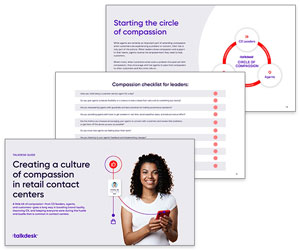It’s easy to develop rapport with someone when you meet them face-to-face. A friendly handshake, the right amount of eye contact: these are the things that build connections. But exactly what do you do when you’re trying to achieve rapport building over the phone? Nick Drake-Knight addresses this very issue.
Have you noticed how some people are super-talented at creating rapport with customers? Chances are they are using techniques, either consciously or unconsciously, that build trust and understanding.
The dictionary definition of rapport is: “A sympathetic relationship or understanding” or, put simply: “being a friend”.
The first rule of rapport building over the phone is to be natural. The challenge in most call centres is that people are required to follow a script format with structured and sequenced question sets. Following pre-set scripted question sets (or statements) limits the flexibility of a person to use his/her own initiative. Scripts provide a consistency of process, but not always a consistency of warmth.
Scripts don’t have to mean robot-like responses, however. Most scripted processes include sufficient flexibility for a degree of natural rapport building. We all know how to build rapport. We don’t need scripts to enjoy the relationships we have with our friends and workmates; it just comes naturally.
We ‘go with the flow’ and chat about matters relating to the subject in hand in a relaxed and friendly manner. The same principle applies to professional rapport building, within a framework of outline scripts that ensure consistency of process.
Key learning points on rapport building over the phone
- Remember that rapport is about being a friend
- Use your active listening skills and become aware of your customer’s ’emotional driver’. It will be either a ‘movement away from pain’ or a ‘planned movement towards pleasure’
- Excellence in communication can be achieved through a conscious effort put in to your use of tonality. Be congruent in tone and words. Really mean what you say
- Try a more upright sitting position, or even stand up to build rapport. It really works
- Remember that ‘clean language’ is a quick win strategy for creating rapid rapport. Use key words employed by the customer to reassure that you have listened and are in tune with him or her
- Rapport building acts as the foundation for the introduction of products and services that could benefit the customer. Without establishing rapport, you are unlikely to get the results you desire
Emotional drivers
The way that language is used in a call centre scenario has profound effects on the thinking and emotional state of customers. Most customers making an in-bound call to a contact centre are doing so because of what we at Performance in People call an ’emotional driver’ – that is, something that motivates them to take action.
This will be either an urge to move away from pain (“I’m late on a payment for my credit card and I’m worried about late payment charges”) or alternatively a planned movement towards pleasure (“I’d like to take out a loan so I can buy a fabulous new car”). The customer expects, or perhaps is hoping, that the call centre operative can help satisfy these urges.
By recognising the emotional driver of the customer, skilled call centre professionals can really ramp up rapport and help the customer satisfy his need for ‘movement away’ or ‘movement towards’ by referring to the driver itself.
Some good examples can be seen in the phrases: “Let’s get to the bottom of this and remove you worry” or “Let’s see if we can help you buy your fabulous new car”.
That’s what the customer wants: positivity, not a script.
Words, song and dance
The challenge in a call centre is that rapport-building options are limited because non-verbal messages are not available to you. We have to rely on the spoken word, tone and inflection to convey warmth, caring and support to the customer.
The Carphone Warehouse employees understand the importance of words, tonality and physiology in customer communication. They call it Words, Song and Dance. It’s a performance.
Most call centre professionals are aware of the differing impacts their words, tonality and physiology have on customers. It’s not just the words that have meaning for customers, it’s the tonality with which they are said (tone, pace, volume and inflection) and the breathing patterns that accompany them.
Albert Mehrabian explored contradictory word-tone-physiology messages in his work in the 1970s. He identified explicitly that it is possible to imply messages that contradict the apparent ‘surface’ message through our use of tone and physiology.
In call centre operations, it is vital that tonality matches – that is, is congruent with – the message contained within a script. We’ve all experienced the call centre operative who delivers his scripted phrase for the umpteenth time in an unenthusiastic tonal style that contradicts the scripted message offering excellence of service.
However, just changing your posture can have a massive impact on how customers perceive you. We know that physiology has an impact on tone.
Experienced operators already know that posture affects the tone of someone’s voice. Being slumped over a desk limits the capacity of the diaphragm to fully inflate and therefore restricts the volume of energy-giving oxygen available for your body.
There is a direct correlation between oxygenated blood flow and mental state. Call centre staff feel better when they breathe well and have the optimum level of oxygen within their blood streams. Being deprived of oxygen is a sure-fire way of making yourself feel listless and ‘down’.
Try a more upright sitting position, or even standing up if it’s possible to do so. You’ll recognise an instant change in your ability to build rapport over the phone with your customers.
The concept of ‘clean language’
One of the coolest rapport-building techniques to use is ‘clean language’. David Grove is credited with the development of this rapport-building technique which employs a simple principle: if I use the same words as you, then we have a greater possibility of creating a rapid rapport based on mutual language use.
In essence, less is more. That is, the less we try to paraphrase or adapt the language used by other people, and the more we use their chosen language, the more likely it is that our fellow communicators will feel a sense of understanding and empathy from us.
This has proven to be a powerful rapport-building technique that is now used extensively in medical and therapeutic environments as a basic model for practitioners.
Where possible, key words from the patient’s language patterns are repeated back by the therapist. And guess what? Clean language works brilliantly in call centres, too.
This is why scripts work best when they are adapted to include the precise language used by the customer. If the customer uses the word ‘insurance cover’ and we talk about ‘warranty’, there is incongruence with the customer’s language.
If the customer talks about his ‘credit card bill’ then make sure you talk about his credit card ‘bill’ and not his ‘statement’. If the customer asks: “When will it arrive?”, don’t say: “It will be delivered on Wednesday”. Instead, explain that “It will arrive on Wednesday”. Clean language is simple to use and creates great rapport, really quickly.
The key thing is to be careful what you say, and be careful how you say it.

Nick Drake-Knight is an author and freelance writer.
Tel: +44 1983 568 080
For more information on building rapport in your contact centre, read these articles next:
- How to Build Rapport on the Phone
- What Is Customer Rapport? And 15 Ways to Build It
- Best Tips, Phrases and Words to Use for Building Rapport
Author: Jonty Pearce
Reviewed by: Megan Jones
Published On: 21st Mar 2007 - Last modified: 22nd May 2024
Read more about - Skills, Empathy, Language, Rapport





































Excellent article on building rapport. Thank You.
fantastic struscture helped me alot!!
Another good article worth sharing to all CSR.. thanks!
We like to be with people who are like us… same goes for our customers. It saves a lot of time talking on the phone.. and brings more satisfied customer by speaking the same language and keeping it clean.
greate tips i will try this tommorow at work im a technical support rep for bb company in new zealand & im always lacking rapport maybe im to technical on my customer hope this helps me cheers!!
Good article, some of the techniques we learned on our NLP courses were to try very quickly to uderstand what thecustomers lead system (modality) was.
Everyone has a lead system and a secondry system, the significence here is that the lead system is used by people to make decisions about well everything. The main 3 systems are visual, kinosthetic, audio, there is also AD (Audio digital).
The clients voice (over the telephone) will often give this away, if they talk in visual modalities a lot they will most probably have a visual lead system. An example of this would be: I am strying to see your point of view but is is not really clear for me.
Once the lead system has been understood the call centre operator can then start to communicate (verbally) using this modality. For instance the operator in the above example might say: I see that you are trying to get a clear picture of the situation at our end and I will try to ensure that I can provide with a full view of your account.
In my experience it also pays to understand pacing and leading (NLP), if you pace the customer (pace is to exactly emulate the customer in as many ways possible) and you do that very well, you will soon be able to lead (powerfully influence) the customer in the direction you are trying to take them. In the call centre situation, you would try to pace them using a) voice tonality b) speed and volume of the speech c)empathy.
Another way of explaining pacing and leading is to imagine you are trying to jump onto a moving train. If you just lunged at it from a standing start, it would be very messy and if you manged to run along side of the train for a few minutes it would be much easier to slide onto it.
When you put all of this together and you use theother skills you mentioned, you will be an amazing tele-sales operator.
Thanks,
John.
good comments.
you have a very informative website or browser i’m going to use the tips all i can say keep up the good work. you will help a lot of job seekers thank you and more power
thanx for excellent article,which is really motivating
great stuff!!!
I would like to know how I can help call center agents be motivated to use customer’s name all throughout the call.
Great! Thank You!
I have an interview on wednesday and I have to do a presentation on ‘how to build up a rapport with your customer’ (its more like an interactive training session that I have to do) I’m not looking forward to it although its something that I can do with my eyes shut on a day to day basis!!!! – this article has really helped me though, Im sure I can make use of some of the stuff in here!!!
*big gulp*
can u pls. include
effective rapport topics?
thanks
Awesome article. Just the kind of information I was looking for. I think I do a lot of this automatically but was trying to find the words to explain it to others. Thanks for your article.